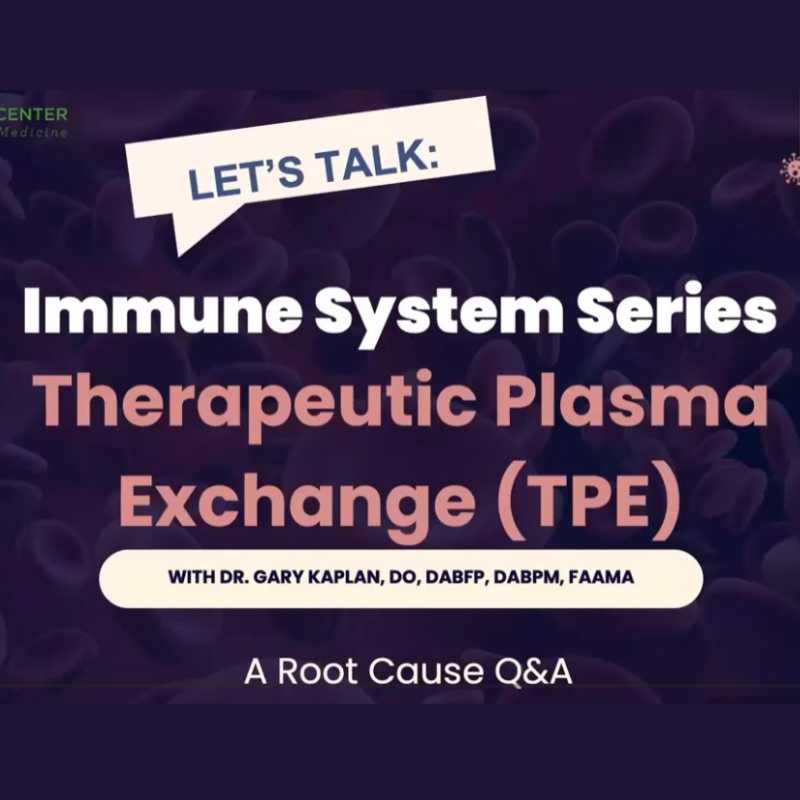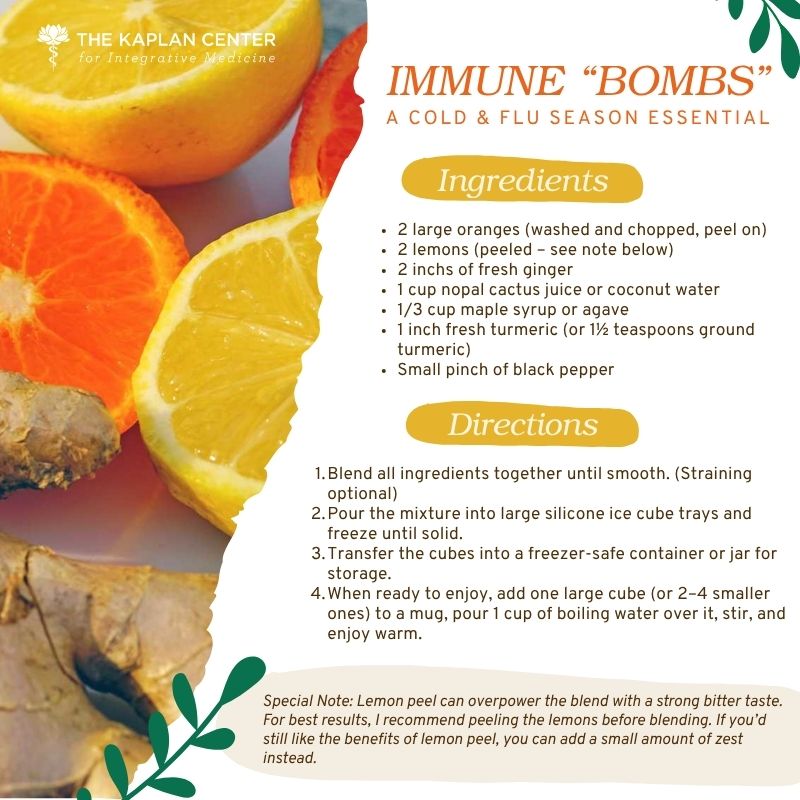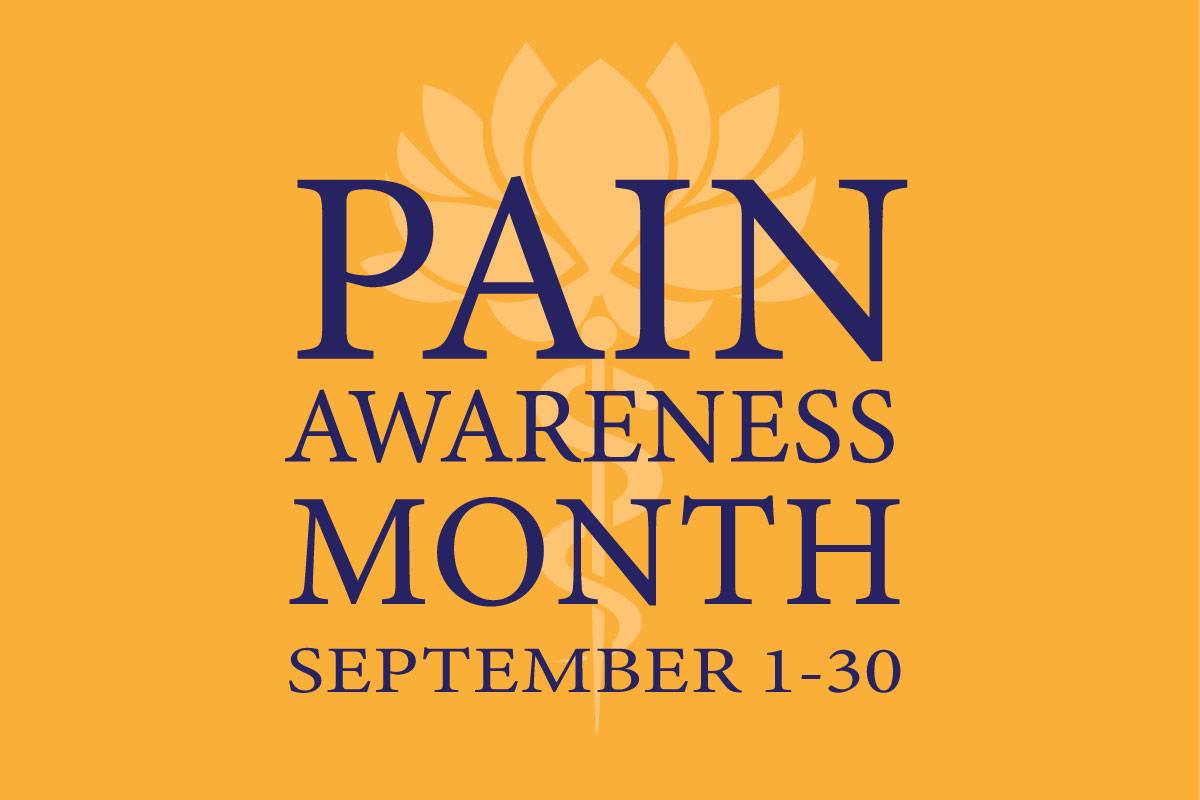
5 Ways We Can Keep Your Immune System Strong
December 10, 2025/by Kaplan Center
Want to Take Your Workout to the Next Level Next Year? These Tips Can Help
December 8, 2025/by Kaplan Center
Dr. Kaplan’s Dos and Don’ts of the Holiday Season
December 3, 2025/by Kaplan Center
Let’s Talk Webinar – A Root Cause Q&A
December 2, 2025/by Kaplan Center
Navigating Holiday Meals with Gut Issues: Simple Tips for a Comfortable Season
December 1, 2025/by Chardonée Donald, MS, CBHS, CHN, CNS, LDN
Craniosacral Therapy for TMJ | Say Goodbye to the Daily Grind
November 19, 2025/by Patricia Alomar, M.S., P.T.
From Compassionate Care to Personal Healing: A Letter to My Patients
November 18, 2025/by Kaplan Center
8 Steps to a Healthier Gut—and a Longer, Healthier Life
November 18, 2025/by Kaplan Center
Mid-Life Irritability & Fatigue Improved by Hormonal Balancing
November 13, 2025/by Lisa Lilienfield, MD
From Challenges to Change: Dr. Kaplan on Healthcare’s Biggest Challenges
October 29, 2025/by Kaplan Center
Overlooked Dangers of Mold Exposure and How to Stay Safe – Dr. Kaplan Talks to WUSA9
October 27, 2025/by Kaplan Center
Let’s ‘Fall’ Into Wellness: A Nutritionist-Approved Immune-Boosting Recipe for Cold and Flu Season
October 13, 2025/by Chardonée Donald, MS, CBHS, CHN, CNS, LDN
PANS/PANDAS – When Sudden Symptoms Signal Something More
October 9, 2025/by Kaplan Center
Beating Burnout, A Nutritionist’s Perspective
October 1, 2025/by Chardonée Donald, MS, CBHS, CHN, CNS, LDN
3 Things That Can Happen After Stopping GLP-1s
September 11, 2025/by Chardonée Donald, MS, CBHS, CHN, CNS, LDN
What Families Need to Know About COVID and Flu Season
September 3, 2025/by Kaplan Center
September is Pain Awareness Month
September 1, 2025/by Kaplan Center
Dr. Kaplan Spoke to Northern Virginia Magazine About COVID, Flu, and Immunity — Here’s What You Should Know
August 14, 2025/by Kaplan Center
“Why Do I Feel Like Crap?”: The Overlap Between Long COVID and Perimenopause
July 30, 2025/by Kaplan Center
Why People Are Turning to EMDR (and Why You Might Want to Too)
July 23, 2025/by Kaplan CenterAre you looking to improve your overall wellness?
Personalized care you can trust.
Our integrative, non-surgical treatment approach is highly successful in maintaining wellness and also treating chronic pain and illness. For more than 30 years, we have delivered superior, cutting-edge health care in the Washington, DC area.
QuickLinks
Contact Information
Tel: 703-532-4892
Fax: 703-237-3105
6829 Elm Street, Suite 300
McLean, Virginia 22101
Map It
Hours of Operation
Mon – Thu : 8 am – 5 pm, ET
Fri : 8 am – 12 pm, ET
Moving Beyond Trauma: Healing Therapies for PTSD
/in Mental Health, Treatments/by Kaplan CenterAccording to the U.S. Department of Veteran’s Affairs, it is estimated that approximately 6% of the population will experience Post-Traumatic Stress Disorder (PTSD) at some point in their lives. By some estimates, that percentage more than doubles for people who have been exposed to a traumatic event.
To be diagnosed with PTSD one must meet a specific set of criteria which includes:
How does one move beyond this emotional pain, or provide support to the most vulnerable population, our children? The following 3 therapies have shown to be effective in treating PTSD in clinical settings for both adults and children.
Family or Couples Therapy
PTSD is a family illness. Family members often experience feelings of guilt, sadness, and isolation when a loved one is suffering. A safe setting where emotions, fears, and concerns can be communicated under the guidance of a therapist can help strengthen relationships and promote group healing during difficult times.
Mindfulness-Based Stress Reduction (MBSR)
MBSR is a program that uses meditation, breathing techniques, and movement, such as yoga, to bring awareness to the present moment, without judgment. There is a growing body of medical research that shows that a mindfulness-based meditation practice can help people bounce back after highly stressful situations.
Eye Movement Desensitization and Reprocessing (EMDR) therapy
EMDR is an integrative psychotherapy that has proven highly effective for the treatment of trauma. Traumatic memories are memories that tend to be “frozen in time” and each time they are triggered a person may re-experience the same disturbing sights, sounds, smells, feelings, and sensations suffered during the original event. Traumatic memories have a long-lasting impact because they change core beliefs that we hold about ourselves and the world around us.
EMDR helps the brain adaptively process traumatic information by replicating what naturally happens during dreaming or REM (rapid eye movement) sleep. During EMDR therapy, a person is asked to bring a difficult thought or memory to mind, holding it in awareness, while also following the therapist’s hand movements across the field of vision, mimicking the biological process of REM sleep. Over time, though an event may remain as a bad memory, it eventually ceases to be a physiological stressor, because the person has learned to experience disturbing events or memories in a new and less distressing way.
Left unresolved, PTSD can be devastating, but with appropriate support, there are ways to move beyond the pain. If you or a loved one may be affected, please seek help – no one needs to suffer alone.
Additional Resources:
National Suicide Prevention Lifeline –24-hour hotline for anyone in emotional distress: 1-800-273-TALK (8255).
National Alliance on Mental Illness (NAMI) – Helpline: 1-800-950-NAMI (6264)
TRE® – Tension and Trauma Releasing Exercise methods by Dr. David Berceli
Veterans Crisis Line – For veterans and their families and friends: 1-800-273-8255
We are here for you, and we want to help.
Our goal is to return you to optimal health as soon as possible. To schedule an appointment please call: 703-532-4892 x2
This article was published in May 2017. It was reviewed and updated in June 2023.
What Can a Certified Nutrition Specialist Do for You?
/in Nutrition/by Kaplan CenterGood nutrition is essential for preventing disease and attaining optimal health in any individual, and it is especially critical for those with chronic diseases such as Diabetes, fibromyalgia, Celiac disease and heart disease. Nutritional deficiencies, genetic weaknesses, food sensitivities and allergies can all contribute to chronic pain in two major ways: 1) by causing tissue inflammation and 2) by interfering with the proper absorption of the nutrients you need to stay healthy.
Certified Nutrition Specialist (CNS) is the most advanced certification for personalized nutrition practitioners, having met the standards set by the American Nutrition Association® through its Board for Certification of Nutrition Specialists. Certified Nutrition Specialists have the expertise and training to evaluate your unique medical history and assist in making the necessary dietary and lifestyle changes you need to improve and maintain your health using science-based advanced medical nutrition therapy, education, and research.
Here are a few examples of the benefits of working with a Certified Nutrition Specialist:
Chardonée is a Board-Certified Nutrition Specialist and Licensed Dietitian Nutritionist. She is also a 3rd year Ph.D. candidate in the Integrative and Functional Nutrition Program at Saybrook University. Chardonée has a Bachelor of Science in Biomedical Science with a Minor in Nutrition and a Master of Science in Human Nutrition. Read more about Chardonée –>>.
Regardless of where you stand in defining and pursuing your personal nutritional goals, you may find that the path to proper nourishment is oftentimes fraught with obstacles. Let us help you overcome those challenges and successfully achieve your goals. To make an appointment today, call 703-532-4892.
We are here for you, and we want to help.
Our goal is to return you to optimal health as soon as possible. To schedule an appointment please call: 703-532-4892 x2
Build a Healthier Brain With Fat!
/in Mental Health, Nutrition/by Gary Kaplan, DOWe don’t usually associate increasing the amount of fat in our diets as a way to improve health, but when it comes to a particular type of fat, that’s exactly what the doctor ordered!
Omega-3 fatty acids are polyunsaturated fatty acids (PUFAs), a type of essential fat involved in several metabolic processes, and they are a crucial component of good health.
Research shows omega-3 fatty acids reduce inflammation and may reduce the risk of chronic diseases such as heart disease, cancer, and arthritis – conditions that often have a high inflammatory process at their root. But most impressive is the research that confirms Omega-3’s benefits on the brain.
There are 11 different types of omega-3s, but the most well-known for their beneficial properties are Alpha-linoleic acid (ALA), Docosahexaenoic acid (DHA) and Eicosapentaenoic acid (EPA).
Dietary sources of ALA, DHA, and EPA
The modern American diet is typically low in Omega-3 and high in Omega-6 fatty acids, another form of polyunsaturated fatty acid found in some vegetable oils (like corn, soybean, and cottonseed oils), nuts and seeds. Too much Omega-6 causes inflammation; therefore, avoiding processed foods that contain them is important. Interestingly, too much Omega-3 can also be bad; it’s all about keeping the ratio of Omega-3 to Omega-6 in check.
A well-balanced diet with natural sources of ALA, DHA, and EPA is fundamental to maintaining a healthy ratio that prevents inflammation and promotes long-term health.
DHA and EPA are found in fatty, cold-water fish, such as salmon, trout, cod liver, herring, mackerel, and sardines, as well as shellfish such as shrimp, oysters, clams, and scallops. Fish is the best source of Omega-3s as DHA and EPA are more bioavailable, meaning it is easier for the body to absorb it over ALA. Whenever possible, purchase wild-caught fish and check out SeafoodWatch.org to see which fish are lowest in mercury and other environmental toxins.
ALA comes from plants and is the most largely consumed form of Omega-3 in the typical American diet. It serves as an energy source for our cells and a small percent is converted into DHA and EPA. Dietary sources of ALA include flax seeds and flax oil, walnuts and walnut oil, chia seeds, pumpkin seeds, hemp seeds, and hemp oil, mustard oil, most leafy green vegetables, and tofu.
Some research is being done on algal oil, as it contains both DHA and EPA making it more bioavailable than other plant sources of Omega-3s. For vegans and vegetarians, this may be a promising alternative to fish oils. Some supplement brands have already started creating vegetarian EPA/DHA supplements from algal oil for those who prefer not to take fish oils.
Supplementation
When diets don’t meet the mark, supplementation may be recommended, but should always be done under the supervision of a doctor and dietitian for these reasons:
1) A doctor and/or a dietitian-nutritionist can monitor the ratio of Omega 3:6. Certain health conditions may benefit from additional Omega-3; in this case, proper dosage should be determined by a doctor.
2) When a diet is already rich in Omega-3, supplementation may throw a proper Omega 3:6 ratio off-balance and unintentionally cause inflammation.
3) There are some supplements of omega-3 that are actually inflammatory. Many retail brands of Omega-3 or fish oils come from sources of fish that are fed an atypical diet of corn and soy, which alters the composition of fatty acids in the fish oil. This can cause inflammation. As supplements do not require FDA approval, a dietitian or doctor can recommend a trusted brand.
Effects of Omega-3 Fatty Acids on the Brain
– Neuropsychiatric conditions: Research shows that Omega-3 fatty acids can be effective in treating depressive conditions, such as Major Depressive Disorder and bipolar disorder.
– Post-stroke & post-concussion: A study published in the Journal of American College of Nutrition found that giving DHA post-concussion helps in the repair and recovery from injury.
A 2015 study published in the Journal of Neuroimmunology found evidence that supported the clinical use of Omega-3 in treating “stroke and other acute neurological diseases” due, in part, to its anti-inflammatory and anti-apoptotic (prevention of cell death) properties.
– Neuropathic pain: Neuropathic pain, or pain due to damage of the peripheral or central nervous system, can cause debilitating pain for those affected.
A 2018 study found that patients with neuralgic pain who were treated with omega-3 fatty acids in conjunction with conventional medicine, reported more improvement in pain intensity and quality of life than those who received conventional medicine alone.
In 2010, a review of case studies found that patients with neuropathic pain who were treated with high doses of Omega-3 fish oil had “clinically significant pain reduction” and improved function.
– Migraines: Diets high in Omega-3 fatty acids have been found to lessen the frequency and occurrence of migraine headaches.
– Neurodegenerative disease: DHA is extremely important for brain development and function. Studies show that when DHA levels are low, the brain is more susceptible to degeneration.
Omega-3 fatty acids help scavenge free radicals (atoms, molecules, or ions with unpaired electrons) that attach inappropriately to tissue and damage it.
A study published in The FASEB Journal found that “omega-3 polyunsaturated fatty acids, which are found in fish oil, could improve the function of the glymphatic system, which facilitate the clearance of waste from the brain, and promote the clearance of metabolites including amyloid-β peptides, a primary culprit in Alzheimer’s disease.”
Studies also show that DHA supplementation can improve cognitive performance.
How much is enough?
Eating a Mediterranean diet with plenty of fruits, vegetables, whole grains, nuts, lean meat, and cold-water fish will help a person consume more Omega-3’s on a regular basis. Current literature advises that at least 2, 3.5 oz. portions of oily fish should be eaten weekly, but does this amount support long-term health?
Determining the correct intake of Omega-3 fatty acids depends on an individual’s age, the overall state of physical and mental health, and whether there is a history of trauma that suggests heightened inflammation. To find out the amount that is best for your unique condition, make sure to consult with your health care provider or schedule an appointment at the Kaplan Center.
We are here for you, and we want to help.
Our goal is to return you to optimal health as soon as possible. To schedule an appointment please call: 703-532-4892 x2
This article was originally published on December 2016. It was reviewed and updated in June 2023.
Additional research:
Omega-3 DHA and EPA for cognition, behavior, and mood: clinical findings and structural-functional synergies with cell membrane phospholipids.
Targeted alteration of dietary n-3 and n-6 fatty acids for the treatment of chronic headaches: a randomized trial.
Association between serum long-chain omega-3 polyunsaturated fatty acids and cognitive performance in elderly men and women: The Kuopio Ischaemic Heart Disease Risk Factor Study
Omega-3 fatty acids and brain resistance to aging and stress: body of evidence and possible mechanisms.
Therapeutic use of omega-3 fatty acids in severe head trauma.